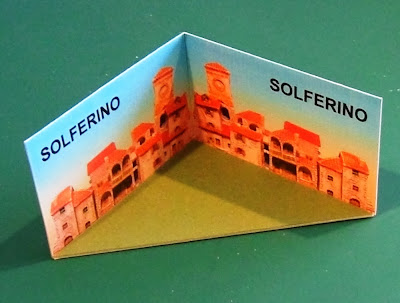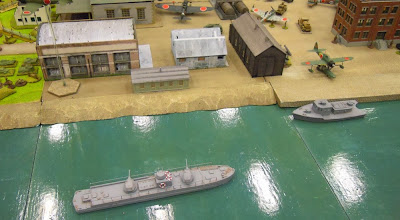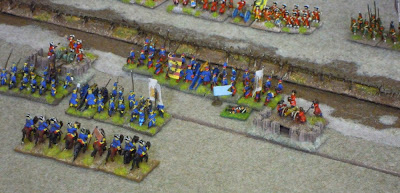One of the 'incidents' that
meeting Neil Fox brought to mind occurred during the famous
MADASAHATTA campaign that we both took part in over the course of a year many years ago. The campaign was fought out on the large table in the basement of Eric Knowles's shop 'New Model Army' in Manor Park, East London.
During the early stages of the campaign I wrote a number of newspaper-style bulletins about the campaign, one of which covered the intervention of the Imperial Japanese Navy in the naval side of the campaign.
(Please note that on the evening that this battle was fought, I was in command of the Japanese squadron!)
FURIOUS FUSO!
by Our Correspondent
The Japanese Squadron, which is commanded by Vice Admiral Iama Quitageza, has already made its mark upon the course of the War in this area. The Squadron, which consists of the dreadnought battleship FUSO, the cruisers NISSHIN and SOYA, and two destroyers, was on its way to the Island when it intercepted the combined might of the German and Turkish Navies in this area.
The enemy fleet consisted of the battleships KAISER FREDERICK III (which had only recently arrived in this area), HEIREDDIN BARBAROSSA, TORGUD REIS, the cruisers REGENSBERG, DRESDEN and MUIN-I-ZAFFAR, the gunboat MUCHE and the patrol-ship ILTIS, and is thought to have been commanded by the German Admiral Hans Off.
As soon as both sides came into view of one another both fleets opened fire, and the Japanese opening salvos caused considerable damage. This can be seen by the examination of the gunnery log of the Japanese flagship FUSO –
1st Salvo – Enemy cruiser (later known to be the REGENSBERG) disabled.
2nd Salvo – German battleship KAISER FREDERICK III sunk. (It is thought that at least one of the FUSO's shells penetrated the armour on the aft 12-inch magazine and this caused the KAISER FREDERICK III to blow up.)
3rd Salvo – Near hits on enemy cruiser.
4th Salvo – Further near hits on enemy units.
5th Salvo – Enemy cruiser (known to be the DRESDEN) sunk as a result of 9 simultaneous hits.
6th Salvo – MUIN-I-ZAFFAR hit and sunk by several direct hits from 14-inch shells.
7th Salvo – Turkish battleship HEIREDDIN BARBAROSSA badly damaged by several direct hits and near misses.
8th Salvo – HEIREDDIN BARBAROSSA sunk by further hits by 14-inch shells.
9th Salvo – TORGUD REIS explodes as a result of several direct hits from the guns of the FUSO, NISSHIN and SOYA.
As can be seen from the above extract the Japanese shooting during the battle was excellent, and this is a result of the training the Japanese Navy has had at the hands of a British Naval Mission, and we remind our readers that many of the Japanese ships in service at the moment are either British built or designed.
It is reported that now that they have discharged their obligations to the British, the Japanese are expected to return home in the very near future in order to assist in the reduction of other Enemy colonies in the Far East.
This battle was fought using Fletcher Pratt's Naval War Game Rules ... and I have never, ever managed to replicate the accuracy of my distance estimation again! At the time I was even accused of having had my glasses calibrated because my 'estimations' were so accurate ... but the truth of the matter is that on that evening I just could not do anything wrong.
These things sometimes happen in wargaming ... and the memory of them lives on for a long time afterwards.
























































































